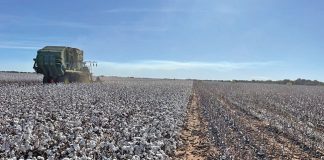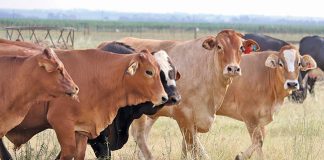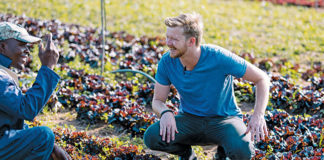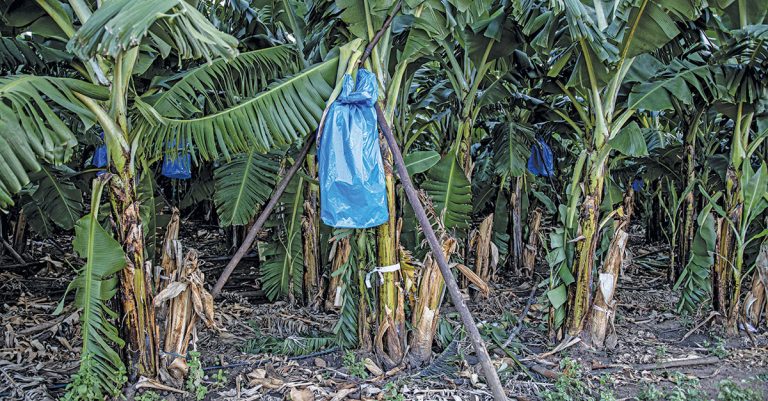
Photo: Lloyd Phillips
A visit to the operational nerve centre of Heystek Farming, situated in the Pongola area of northern KwaZulu-Natal, reveals a highly organised and diversified farming operation that is clearly the pride of brothers Riaan and WJ Heystek.
There are fields of irrigated sugar cane and green peppers, citrus orchards, banana plantations and cucumber tunnels.
Their father, Willie, established Heystek Farming, but today focuses on managing the farm’s finances, while Riaan and WJ run the operation. In addition, the pair manage a separate entity, Heystek Farm Produce (HFP), which they established in 2013 to farm mainly jam tomatoes.
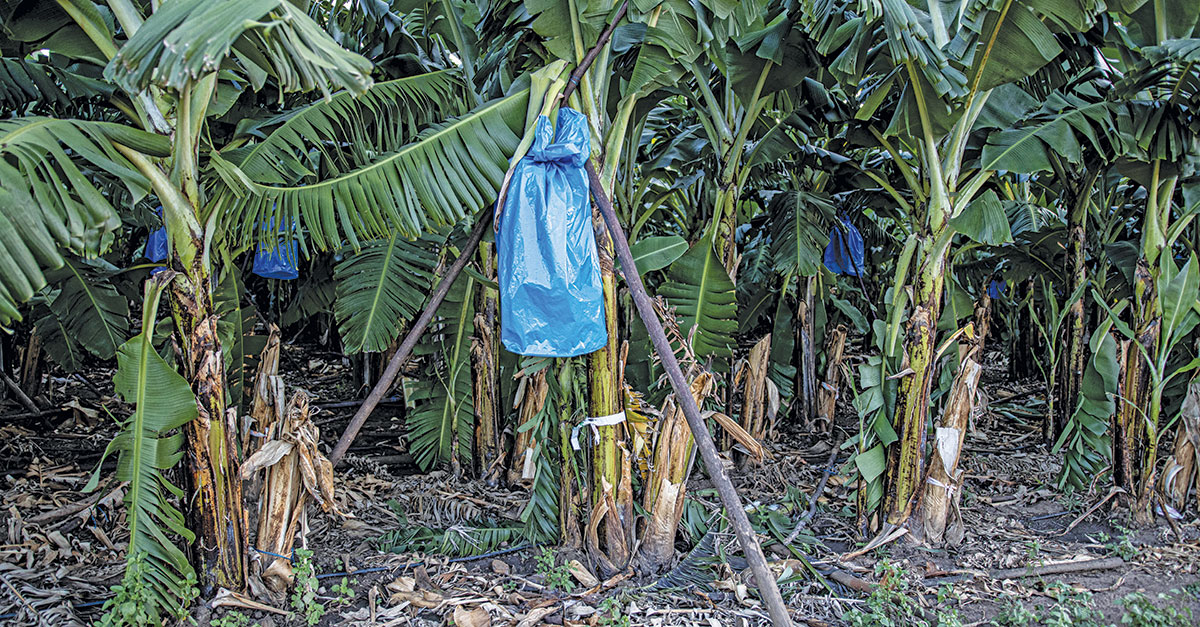
Bananas, which the brothers first planted in December 2019, are HFP’s latest enterprise.
“We chose bananas because we know they grow well in Zululand’s subtropical climate,” explains Riaan.
“They’re also very popular among fresh-produce hawkers. For years, we’ve been supplying our other fresh produce to local informal traders. We have a good business relationship with them, and they told us they’d be willing to buy our bananas.”
Riaan and WJ ploughed out the sugar cane fields closest to HFP’s ripening rooms and packhouse so that future banana harvests would not have to be transported far to these facilities. Bananas bruise easily, so the less they are handled, the less risk of the consumer ending up with unappealing fruit.
In addition, the soil of the ploughed-out sugar cane fields has a relatively high clay content (between 25% and 40%), a beneficial soil organic carbon content of 2% to 3%, and high water-holding capacity. Banana plants do well in such soil conditions.
Making a good bed for bananas
“After harvesting the sugar cane, we let the field stand for approximately four weeks,” says WJ. “During this time, we irrigated it lightly to enable the sugar cane leaves to regrow so that we could apply glyphosate herbicide to the young plants.
“The glyphosate, which is systemic, kills whole sugar cane plants as well as any weeds growing in the fallow field before bananas are planted.”
The dying plants were then disced into the soil using a disc harrow. The decomposing plants helped improve soil structure and provide organic nutrients for the banana plants.
Discing was followed by a subsoiler to loosen any compaction down to a depth of 600mm to improve aeration and moisture dispersion within the soil, and to enable the roots of the banana plants to grow unimpeded.
The soil was then disced again, and this was followed by a power harrow that created a fine soil tilth. The tilth was necessary for the important root-to-soil contact needed by the banana seedlings once they were transplanted into the field.
“Our banana fields are cambered, so we plant the seedlings in rows that run along the contours. This minimises soil erosion and exposure of the plants’ adventitious and relatively shallow roots to the air,” explains Riaan.
“After the power harrow has gone through, we use a furrow ridger to create furrows to a depth of 300mm. This also forms the planting lines for the banana seedlings.”
Correct planting depth is important for ensuring that any suckers that develop from the seedling, which becomes the ‘mother plant’, do not push the mother plant’s roots out of the soil, says Riaan. This would expose the roots to the sun, resulting in sunburn.
HFP sources its banana seedlings from the Du Roi laboratory and nursery operation in Limpopo’s Tzaneen area. It is a specialist in the culturing and propagation of disease-free plants.
The banana seedlings are propagated from tissue of the widely grown Williams variety. According to the brothers, the seedlings are free of commercially important plant pathogens such as Panama disease, banana bunchy top virus, and yellow Sigatoka
leaf spot.
The Heysteks will not replant old banana plantations with suckers cut from their existing standing plants, as this would increase the risk of the plantations being re-established with diseases.
The small banana seedlings from Du Roi are transported to Hoek Seedlings in the Pongola area. Here, they are grown further and hardened in a protected environment to between 30cm and 40cm in height. They are then transported to HFP’s nearby fields for transplanting.
Hardened banana seedlings are more tolerant of transplant stress. Since their first transplanting of banana seedlings in December 2019, the brothers have discovered that the ideal time for transplanting on their farm is in October and November. By December, the transplanted banana seedlings can tolerate the stronger sunlight and higher daytime temperatures, and can take advantage of the heavier rains, which usually saturate the soil.
Transplanting
Planting pits are dug at the bottom of each 30cm-deep furrow using a spade. Each pit is four-sided (20cm per side and 25cm deep), with special care taken to avoid leaving spade smears on the walls inside the pit.
These spade smears are likely to dry and harden, causing a pan that prevents the banana seedling’s roots from growing freely into the surrounding soil. A seedling is then transplanted by hand into each pit.
“Hand-planting takes time, so we don’t want all of our seedlings delivered in a single day from Hoek Seedlings, because they’ll be standing on the side of the field in the heat,” says Riaan.
“We can hand plant approximately 1 200 a day. Our population on the 5ha of bananas that we have right now is 2 000/ha.”
HFP’s transplanted banana seedlings are spaced 1,8m apart within the row and the
rows are 2m apart. This inter-row spacing is slightly narrower than the industry norm to accommodate the spacing of the existing drip irrigation.
An advantage of these spacings for the operation’s bananas is that if the Pongola area’s strong winds blow some mature banana plants over, they can lean on their immediate neighbours, rather than falling flat on to the ground, until farm staff can prop them up again.
“We use our drip system, which is the most water-efficient type of irrigation there is, to apply supplementary water to our newly transplanted bananas from December through to April,” says Riaan.
“We stop irrigating from May to August when local temperatures are cooler and the plants’ water uptake has slowed significantly. We then irrigate the plants, which are now much bigger, from September to April.”
In summer, the older banana plants require 18mm of water every three days; during some of the cooler months they need 12mm every five days.
Fertigation, pests and disease
Another advantage of HFP’s drip irrigation system is that it can be used to fertigate the banana plants with the 800kg/ha of potassium and 275kg/ha of nitrogen they require each year.
WJ says that for the first 13 months after being transplanted, HFP’s banana plants are rarely threatened by any major pests and diseases. However, he and Riaan need to scout for soil nematodes, which attack and damage the plants’ roots.
As a proactive strategy, the brothers apply a nematicide via the drip irrigation system every three months. Weeds are hoed manually.
It takes about 12 months from transplanting before a banana plant begins bearing fruit for harvesting. According to WJ, this first harvest is unlikely to indicate a plantation’s full potential.
He and Riaan achieved around 30t/ ha from their first harvest in early 2021. They are hoping for 40t/ha from the second harvest and 50t/ha from the third harvest onward.
“As a banana plant grows towards fruit production and harvest, it puts out suckers
which will each create a new plant that grows and produces fruit,” explains WJ.
“In commercial banana production, you don’t want all of these suckers to grow randomly around the parent plant. Instead, you select one sucker growing from each parent plant in the row, and that’s in the direction that you want to ‘march’ all of the banana plants in the plantation. All of the unwanted suckers are cut off from the parent plants.”
Once the single bunch of bananas is harvested from a parent plant, the plant is cut down to leave a 1m-length of standing stem as a source of stored nutrients for the attached sucker to use until it develops its own roots. This prevents the parent plant from competing with the banana plant growing from the sucker for water, nutrients, space and light.
Getting the most from the plants
HFP intends conducting sucker selection until at least 10, but hopefully 15, profitable harvests have been achieved and the plantation must be replanted with new seedlings.
“The costs of establishing and getting a banana plantation to its first harvest is about R120 000/ha at the moment. This includes the costs of the seedlings, labour, irrigation, fertigation, the bags used to protect the growing bunches and the poles to help keep the plants standing upright. Some of these can be reused, and so the management costs come down somewhat in later years,” says WJ.









